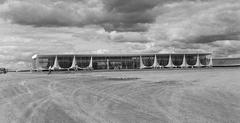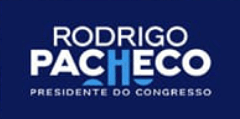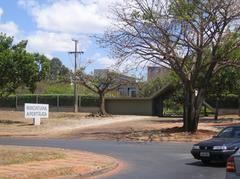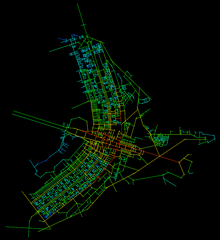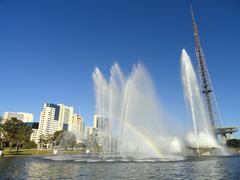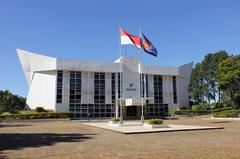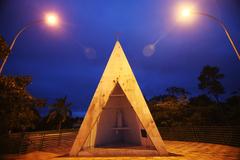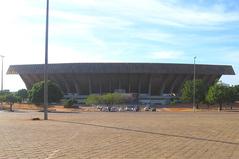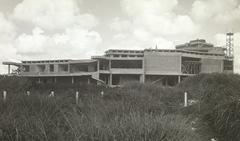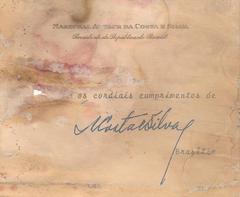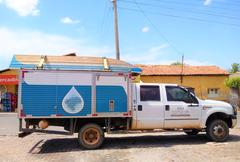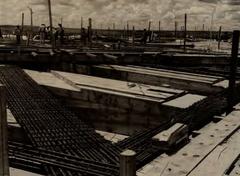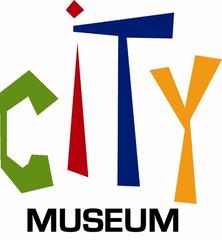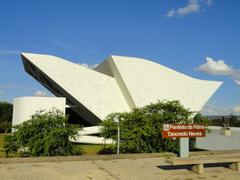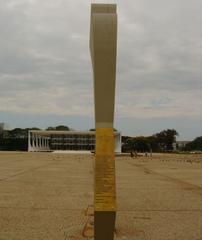इतामराती पैलेस: ब्रासीलिया में देखने का समय, टिकट और ऐतिहासिक महत्व
दिनांक: 14/06/2025
परिचय
इतामराती पैलेस, जिसे ‘आर्चिस का महल’ के नाम से भी जाना जाता है, ब्रासीलिया के मध्य में स्थित एक वास्तुशिल्प और राजनयिक खजाना है। ब्राजील के विदेश मंत्रालय के मुख्यालय के रूप में, यह न केवल देश के आधुनिकतावादी वास्तुशिल्प आंदोलन का प्रतीक है, बल्कि ब्राजील की खुलेपन, कूटनीति और सांस्कृतिक पहचान के प्रति प्रतिबद्धता का प्रमाण भी है। यह व्यापक मार्गदर्शिका महल की उत्पत्ति, वास्तुशिल्प मुख्य आकर्षणों, सांस्कृतिक महत्व, देखने के समय, टिकट प्रक्रियाओं, पहुंच और यात्रा युक्तियों का विवरण देती है ताकि आप ब्रासीलिया के सबसे महत्वपूर्ण ऐतिहासिक स्थलों में से एक की यादगार यात्रा की योजना बना सकें (आर्चडेली; 360 मेरिडियानोस; गूगल आर्ट्स एंड कल्चर)।
उत्पत्ति और ऐतिहासिक विकास
रियो डी जनेरियो से ब्रासीलिया तक
इतामराती पैलेस की वंशरेखा रियो डी जनेरियो में अपने नाम वाले महल तक जाती है, जिसने सत्तर वर्षों से अधिक समय तक ब्राजील के विदेश मंत्रालय को आश्रय दिया था। “इतामराती” शब्द तुपी भाषा में निहित है, जिसका अर्थ है “छोटी चट्टानों की नदी”, जो ब्राजील की स्वदेशी विरासत और विविधता को अपनाने वाले मंत्रालय को उजागर करता है (NGOs के लिए धन; 360 मेरिडियानोस)।
1960 में, राष्ट्रपति जुसेलिनो कुबित्शेक के तहत ब्रासीलिया को नई संघीय राजधानी के रूप में उद्घाटन किया गया, जिससे एक नए इतामराती पैलेस के निर्माण की शुरुआत हुई, जिसका आधिकारिक तौर पर 21 अप्रैल, 1970 को उद्घाटन किया गया (विकिपीडिया; आर्चडेली)।
वास्तुशिल्प संदर्भ और प्रतीकवाद
ब्राजीलियाई आधुनिकता के एक अग्रणी ऑस्कर निएमेयर ने महल को रूप, पारदर्शिता और राष्ट्रीय पहचान के उत्सव के रूप में डिजाइन किया था। इमारत की सबसे विशिष्ट विशेषता 28 स्मारक कंक्रीट मेहराबों का स्तंभ है, जो एक शांत प्रतिबिंबित पूल के ऊपर तैरते हुए दिखाई देते हैं। राष्ट्रीय कांग्रेस के पास स्थित मिनिस्टरीज एस्प्लेनेड में स्थापित यह डिजाइन, निएमेयर के कामुक, वक्रतापूर्ण रेखाओं के दर्शन का प्रतीक है, बल्कि राजनयिक खुलेपन और स्पष्टता का भी प्रतीक है (आर्किटेक्टुरा विवा; 360 मेरिडियानोस)।
रॉबर्टो बर्ले मार्क्स द्वारा डिजाइन किए गए बगीचों के साथ महल का एकीकरण और एथोस बल्काओ और कैंडिडो पोर्टिनारी जैसे कलाकारों के कार्यों का समावेश वास्तुकला, परिदृश्य और कला का एक अनूठा मिश्रण बनाता है (ब्रासीलिया के बारे में)।
राजनयिक और संस्थागत महत्व
”इतामराती” एक प्रतीक के रूप में
ब्राजील के भीतर, “इतामराती” विदेश मंत्रालय का पर्याय बन गया है, जो राष्ट्र के राजनयिक इतिहास में महल की केंद्रीय भूमिका को दर्शाता है। 1822 में अपनी स्थापना के बाद से, मंत्रालय ने शांतिपूर्ण संघर्ष समाधान और बहुपक्षवाद को बढ़ावा दिया है, जिससे अंतरराष्ट्रीय मंच पर ब्राजील की प्रतिष्ठा बढ़ी है (विकिपीडिया; विकिपीडिया; द काहिरा रिव्यू)।
कूटनीति का मंच
महल अंतरराष्ट्रीय शिखर सम्मेलनों, राज्य यात्राओं, संधि हस्ताक्षर और भव्य स्वागत समारोहों की मेजबानी के लिए प्रसिद्ध है, जिसमें राष्ट्रपति उद्घाटन भोज भी शामिल हैं। इसके कला संग्रह में ब्राजीलियाई मास्टर्स और अंतरराष्ट्रीय कलाकारों के काम प्रदर्शित हैं, जबकि ऊपरी मंजिल राजकुमारी इसाबेल की डेस्क को संरक्षित करती है, जिसका उपयोग दासता को समाप्त करने वाले लेई ऑरिया पर हस्ताक्षर करने के लिए किया गया था - मानवाधिकारों के प्रति ब्राजील की प्रतिबद्धता का एक शक्तिशाली प्रतीक (360 मेरिडियानोस; ब्रासीलिया के बारे में)।
राजनयिकों का प्रशिक्षण: रियो ब्रान्को संस्थान
महल के भीतर स्थित, रियो ब्रान्को संस्थान ब्राजील का सबसे प्रमुख राजनयिक अकादमी है, जो देश के राजनयिकों की अगली पीढ़ी को पोषित करने के लिए जिम्मेदार है (थॉमसकेलनर.कॉम; द काहिरा रिव्यू)।
देखने का समय, टिकट और आगंतुक जानकारी
समय और प्रवेश
- खुला: मंगलवार से रविवार, सुबह 9:00 बजे – शाम 5:00 बजे
- बंद: सोमवार और सार्वजनिक अवकाश
- प्रवेश: निःशुल्क; निर्देशित पर्यटन के लिए अग्रिम आरक्षण की आवश्यकता है (ट्रिपहोबो; इतामराती आधिकारिक वेबसाइट)
निर्देशित पर्यटन
निर्देशित पर्यटन पुर्तगाली में उपलब्ध हैं, जबकि अंग्रेजी और स्पेनिश पर्यटन अनुरोध पर और पूर्व व्यवस्था के अनुसार पेश किए जाते हैं। पर्यटन महल के वास्तुकला, इतिहास और कला में समृद्ध अंतर्दृष्टि प्रदान करते हैं। सुरक्षा प्रोटोकॉल और सीमित समूह आकारों के कारण अग्रिम बुकिंग की अत्यधिक अनुशंसा की जाती है।
पहुंच
महल पूरी तरह से सुलभ है, जिसमें रैंप, लिफ्ट और विकलांग आगंतुकों के लिए सुलभ शौचालय शामिल हैं।
स्थान और वहां कैसे पहुंचें
Esplanada dos Ministérios, Bloco H में स्थित, महल सार्वजनिक परिवहन, टैक्सी या राष्ट्रीय कांग्रेस और ब्रासीलिया के कैथेड्रल सहित आस-पास के स्थलों से पैदल चलकर आसानी से पहुँचा जा सकता है (ट्रिपहोबो)।
व्यावहारिक सुझाव
- अग्रिम बुकिंग: विशेष रूप से गैर-पुर्तगाली बोलने वालों या समूहों के लिए आवश्यक।
- पहचान: प्रवेश के लिए आवश्यक।
- ड्रेस कोड: स्मार्ट कैज़ुअल पहनावे की सिफारिश की जाती है।
- फोटोग्राफी: अधिकांश सार्वजनिक क्षेत्रों में अनुमति है, लेकिन कुछ कमरों में या आधिकारिक कार्यक्रमों के दौरान प्रतिबंध लागू हो सकते हैं।
- कोई ऑन-साइट कैफे नहीं: ब्रासीलिया के मोन्युमेंटल एक्सिस क्षेत्र में आस-पास भोजन के विकल्प उपलब्ध हैं।
आगंतुक अनुभव: क्या उम्मीद करें
आगमन
आगंतुकों का स्वागत महल के प्रतिष्ठित मेहराबों द्वारा किया जाता है जो इसके शांत तालाब में परिलक्षित होते हैं। सुरक्षा जांच के बाद, गाइड आगंतुकों को मुख्य स्वागत हॉल, ब्राजीलियाई कला से सुसज्जित औपचारिक कमरों और रॉबर्टो बर्ले मार्क्स द्वारा डिजाइन किए गए प्रसिद्ध बगीचों के माध्यम से ले जाते हैं (वीगोट्रिप)।
मुख्य आकर्षण
- मुख्य हॉल: स्तंभ-मुक्त और प्राकृतिक प्रकाश से सराबोर।
- औपचारिक कमरे: ब्राजीलियाई और अंतरराष्ट्रीय कलाकृतियाँ प्रदर्शित।
- बगीचे और तालाब: देशी वनस्पतियों और मूर्तियों, विशेष रूप से ब्रूनो जियोर्गी की “मेटेओरो” की विशेषता।
- कला संग्रह: एथोस बल्काओ, कैंडिडो पोर्टिनारी और अन्य के कार्यों सहित।
सांस्कृतिक महत्व और राष्ट्रीय पहचान
इतामराती पैलेस की वास्तुशिल्प नवीनता, कलात्मक एकीकरण और कूटनीति में केंद्रीय भूमिका इसे ब्राजीलियाई सांस्कृतिक पहचान का एक आधार बनाती है। राष्ट्रीय कांग्रेस और पलासीओ डो प्लानल्टो जैसे अन्य सरकारी भवनों के साथ इसकी उपस्थिति, राजधानी के राजनीतिक और सांस्कृतिक दिल के भीतर इसके महत्व को रेखांकित करती है (द गाइड; आर्किटेक्टुरा विवा)।
महल यूनेस्को विश्व धरोहर स्थल भी है, जिसे ब्रासीलिया की नियोजित शहर और आधुनिकतावादी शहरी उत्कृष्ट कृति के रूप में इसके योगदान के लिए सराहा गया है।
यात्रा सुझाव और सर्वोत्तम समय
- सर्वोत्तम समय: सुखद मौसम के लिए सप्ताहांत की सुबह, विशेष रूप से शुष्क मौसम (अप्रैल-जुलाई) के दौरान (ब्राजील पल्स)।
- आस-पास की साइटों के साथ मिलाएं: महल राष्ट्रीय कांग्रेस, ब्रासीलिया के कैथेड्रल, पलासीओ दा अल्वोराडा और टीवी टॉवर के करीब है (बिगब्लूस्टोन)।
- कम से कम एक घंटा दें: मानक निर्देशित पर्यटन लगभग एक घंटा चलता है - आधे दिन के शहर के कार्यक्रम में फिट करने के लिए आदर्श (ट्रिपहोबो)।
अक्सर पूछे जाने वाले प्रश्न (FAQ)
Q: देखने का समय क्या है? A: मंगलवार से रविवार, सुबह 9:00 बजे से शाम 5:00 बजे तक; सोमवार और सार्वजनिक अवकाश पर बंद।
Q: क्या प्रवेश शुल्क लगता है? A: नहीं, प्रवेश निःशुल्क है, लेकिन निर्देशित पर्यटन के लिए अग्रिम बुकिंग आवश्यक है।
Q: क्या अंग्रेजी में पर्यटन उपलब्ध हैं? A: हाँ, लेकिन अग्रिम रूप से अनुरोध किया जाना चाहिए।
Q: क्या महल सुलभ है? A: हाँ, रैंप, लिफ्ट और सुलभ शौचालयों के साथ।
Q: क्या मैं अंदर तस्वीरें ले सकता हूँ? A: आम तौर पर अनुमति है, लेकिन कुछ क्षेत्रों में या आधिकारिक कार्यक्रमों के दौरान प्रतिबंध लागू हो सकते हैं।
Q: मैं दौरे के लिए कैसे बुक करूं? A: आधिकारिक इतामराती पैलेस वेबसाइट के माध्यम से, फोन द्वारा, या आगंतुक केंद्र में आरक्षित करें।
आस-पास के आकर्षण
- राष्ट्रीय कांग्रेस: प्रतिष्ठित विधायी परिसर।
- ब्रासीलिया का कैथेड्रल: अपने हाइपरबोलॉइड डिजाइन के लिए प्रसिद्ध।
- पलासीओ दा अल्वोराडा: राष्ट्रपति निवास।
- टीवी टॉवर: शहर के मनोरम दृश्य प्रस्तुत करता है।
- गणतंत्र का संग्रहालय: आधुनिक कला और इतिहास प्रदर्शनियाँ।
दृश्य और सुधार
आपकी यात्रा के लिए अनुशंसित छवियां:
- बाहरी: तालाब में परिलक्षित महल के मेहराब।
- आंतरिक: स्तंभ-मुक्त मुख्य हॉल और सर्पिल सीढ़ी।
- बगीचे: रॉबर्टो बर्ले मार्क्स द्वारा डिजाइन की गई देशी वनस्पति।
- कलाकृतियाँ: राजनयिक कार्यक्रमों के दौरान प्रदर्शित।
एक आभासी पूर्वावलोकन के लिए, आधिकारिक वेबसाइट के इंटरैक्टिव मानचित्र और ऑनलाइन गैलरी देखें।
आधिकारिक स्रोत और आगे पढ़ना
- आर्चडेली
- 360 मेरिडियानोस
- गूगल आर्ट्स एंड कल्चर
- ट्रिपहोबो
- इतामराती आधिकारिक वेबसाइट
- NGOs के लिए धन
- ब्रासीलिया के बारे में
- विकिपीडिया
निष्कर्ष
इतामराती पैलेस ब्राजील की राजनयिक परंपरा, वास्तुशिल्प नवाचार और सांस्कृतिक समृद्धि का एक जीवंत प्रतीक है। अपने आधुनिकतावादी डिजाइन, कला और परिदृश्य के सहज मिश्रण, साथ ही विदेश मामलों में अपनी महत्वपूर्ण भूमिका के साथ, यह ब्रासीलिया के आगंतुकों के लिए एक आवश्यक गंतव्य है। सबसे वर्तमान यात्रा के समय और पर्यटन जानकारी के लिए, हमेशा आधिकारिक स्रोतों का संदर्भ लें। मोबाइल गाइड के साथ अपने अनुभव को बेहतर बनाएं और अपने यात्रा कार्यक्रम में आस-पास के स्थलों को शामिल करके शहर की आधुनिकतावादी विरासत का अन्वेषण करें।
अपडेट और यात्रा युक्तियों के लिए, ऑडिएला ऐप डाउनलोड करें और हमसे सोशल मीडिया पर जुड़ें।
ऑडिएला2024{‘date’: ‘14/06/2025’, ‘task’: {‘model’: ‘gpt-4.1-mini’, ‘query’: ‘Comprehensive guide to visiting Itamaraty Palace, Brasília, Brazil: history, significance, visitor tips, and everything tourists need to know for a memorable experience.’, ‘verbose’: False, ‘guidelines’: [“Keyword Research: Identify relevant keywords that potential visitors are likely to search for, such as ‘[Monument Name] visiting hours,’ ‘[Monument Name] tickets,’ and ‘[City] historical sites.’ Use these keywords strategically throughout the article, including in the title, headers, and body text, but avoid keyword stuffing.”, ‘Engaging and Informative Title: Craft a title that is both SEO-friendly and compelling to encourage clicks. Include the main keyword and make it clear what the article will cover.’, ‘Structured Content: Use headings (H1, H2, H3) to organize the content effectively. This helps with SEO and makes the article easier for readers to navigate. Include an introduction that hooks the reader, a detailed body that covers all relevant aspects, and a conclusion that summarizes the key points.’, ‘Comprehensive Coverage: Address common questions and topics of interest such as the history of the monument, its cultural significance, visitor information (e.g., ticket prices, opening hours), travel tips, nearby attractions, and accessibility. Include sections that might be unique to the monument, like special events, guided tours, and photographic spots.’, ‘Quality Content: Ensure the content is well-researched, accurate, and provides real value to readers. Use reliable sources and provide factual information. Write in a clear, engaging, and accessible style. Consider your audience and use language that is appropriate for those likely to visit the monument.’, ‘Visuals and Media: Incorporate high-quality images or videos of the monument. These should be optimized for the web (correct sizing, alt tags with keywords). Consider interactive elements like virtual tours or maps.’, ‘Internal and External Links: Include links to other related articles on your site to encourage deeper engagement (internal links). Link to official websites for the monument or credible sources for further reading (external links).’, ‘FAQ: Incorporate FAQ sections to target voice search queries and featured snippets’, ‘Visit and Stay Up to Date: End the article with a call to action, such as encouraging readers to download our mobile app Audiala, check out other related posts, or follow on social media for more updates.’], ‘max_sections’: 4, ‘publish_formats’: {‘pdf’: False, ‘docx’: False, ‘markdown’: True}, ‘follow_guidelines’: True}, ‘title’: ‘Comprehensive Guide to Visiting Itamaraty Palace, Brasília, Brazil’, ‘report’: ’# Itamaraty Palace: Visiting Hours, Tickets, and Historical Significance in Brasília\n\n#### Date: 14/06/2025\n\n---\n\n## Introduction\n\nThe Itamaraty Palace, also known as the Palace of the Arches, is an architectural and diplomatic treasure situated in the heart of Brasília. As the headquarters of Brazil’s Ministry of Foreign Affairs, it stands not only as a symbol of the country’s modernist architectural movement but also as a testament to Brazil’s commitment to openness, diplomacy, and cultural identity. This comprehensive guide details the palace’s origins, architectural highlights, cultural significance, visiting hours, ticketing procedures, accessibility, and travel tips to help you plan a rewarding experience at one of Brasília’s most important historical sites (ArchDaily; 360 Meridianos; Google Arts & Culture).\n\n---\n\n## Origins and Historical Evolution\n\n### From Rio de Janeiro to Brasília\n\nThe Itamaraty Palace’s lineage traces back to its namesake in Rio de Janeiro, which housed Brazil’s Ministry of Foreign Affairs for over seventy years. The term “Itamaraty” is rooted in the Tupi language, meaning “river of small stones,” highlighting Brazil’s indigenous heritage and the ministry’s embrace of diversity (Funds for NGOs; 360 Meridianos).\n\nIn 1960, Brasília was inaugurated as the new federal capital under President Juscelino Kubitschek, prompting the construction of a new Itamaraty Palace, which officially opened on April 21, 1970 (Wikipedia; ArchDaily).\n\n### Architectural Context and Symbolism\n\nOscar Niemeyer, a pioneer of Brazilian modernism, designed the palace as a celebration of form, transparency, and national identity. The building’s most distinctive feature is its colonnade of 28 monumental concrete arches, which appear to float above a serene reflecting pool. This design, set amidst the Ministries Esplanade near the National Congress, not only embodies Niemeyer’s philosophy of sensual, curvaceous lines but also symbolizes diplomatic openness and clarity (Arquitectura Viva; 360 Meridianos).\n\nThe palace’s integration with gardens designed by Roberto Burle Marx and the inclusion of works by artists like Athos Bulcão and Candido Portinari create a unique fusion of architecture, landscape, and art (About Brasília).\n\n---\n\n## Diplomatic and Institutional Significance\n\n### “Itamaraty” as a Symbol\n\nWithin Brazil, “Itamaraty” is synonymous with the Ministry of Foreign Affairs, reflecting the palace’s central role in the nation’s diplomatic history. Since its establishment in 1822, the ministry has championed peaceful conflict resolution and multilateralism, bolstering Brazil’s reputation on the international stage (Wikipedia; Wikipedia; The Cairo Review).\n\n### A Stage for Diplomacy\n\nThe palace is renowned for hosting international summits, state visits, treaty signings, and grand receptions, including presidential inauguration banquets. Its art collection showcases works by Brazilian masters and international artists, while the upper floor preserves Princess Isabel’s desk, used to sign the Lei Áurea, which abolished slavery in Brazil—a powerful symbol of Brazil’s dedication to human rights (360 Meridianos; About Brasília).\n\n### Training Diplomats: The Rio Branco Institute\n\nHoused within the palace, the Rio Branco Institute is Brazil’s foremost diplomatic academy, responsible for cultivating the country’s next generation of diplomats (Thomaskellner.com; The Cairo Review).\n\n---\n\n## Visiting Hours, Tickets, and Visitor Information\n\n### Hours and Admission\n\n- Open: Tuesday to Sunday, 9:00 AM – 5:00 PM\n- Closed: Mondays and public holidays\n- Admission: Free; guided tours require advance reservation (TripHobo; Itamaraty Official Website)\n\n### Guided Tours\n\nGuided tours are available in Portuguese, with English and Spanish tours offered upon request and prior arrangement. Tours provide enriching insights into the palace’s architecture, history, and art. Booking in advance is highly recommended due to security protocols and limited group sizes.\n\n### Accessibility\n\nThe palace is fully accessible, with ramps, elevators, and accessible restrooms for visitors with mobility challenges.\n\n### Location and Getting There\n\nLocated at Esplanada dos Ministérios, Bloco H, the palace is easily reached by public transportation, taxi, or by walking from nearby landmarks, including the National Congress and the Cathedral of Brasília (TripHobo).\n\n### Practical Tips\n\n- Advance Booking: Essential, especially for non-Portuguese speakers or groups.\n- Identification: Required for entry.\n- Dress Code: Smart casual attire is recommended.\n- Photography: Allowed in most public areas, but restrictions may apply in certain rooms or during official events.\n- No On-site Café: Dining options are available nearby in Brasília’s Monumental Axis area.\n\n---\n\n## Visitor Experience: What to Expect\n\n### Arrival\n\nUpon arrival, visitors are greeted by the palace’s iconic arches reflected in its tranquil pool. After a security check, guides lead visitors through the main reception hall, ceremonial rooms adorned with Brazilian art, and the renowned gardens designed by Roberto Burle Marx (WeGoTrip).\n\n### Highlights\n\n- Main Hall: Column-free and bathed in natural light.\n- Ceremonial Rooms: Display Brazilian and international artworks.\n- Gardens and Pool: Feature native flora and sculptures, notably Bruno Giorgi’s “Meteoro.”\n- Art Collection: Includes works by Athos Bulcão, Candido Portinari, and others.\n\n---\n\n## Cultural Importance and National Identity\n\nThe Itamaraty Palace’s architectural innovation, artistic integration, and central role in diplomacy make it a keystone of Brazilian cultural identity. Its presence alongside other government buildings, such as the National Congress and Planalto Palace, underscores its significance within the political and cultural heart of the capital (The Guide; Arquitectura Viva).\n\nThe palace is also a UNESCO World Heritage site, lauded for its contribution to Brasília’s status as a planned city and modernist urban masterpiece.\n\n---\n\n## Visiting Tips and Best Times\n\n- Best Time: Weekday mornings, especially during the dry season (April–July) for pleasant weather (Brazil Pulse).\n- Combine with Nearby Sites: The palace is close to the National Congress, Cathedral of Brasília, Palácio da Alvorada, and the TV Tower (BigBlueStone).\n- Allow at Least One Hour: Standard guided tours last about an hour—ideal for fitting into a half-day city itinerary (TripHobo).\n\n---\n\n## Frequently Asked Questions (FAQ)\n\nQ: What are the visiting hours? \nA: Tuesday to Sunday, 9:00 AM to 5:00 PM; closed on Mondays and public holidays.\n\nQ: Is there an admission fee? \nA: No, admission is free, but advance booking is required for guided tours.\n\nQ: Are tours available in English? \nA: Yes, but must be requested in advance.\n\nQ: Is the palace accessible? \nA: Yes, with ramps, elevators, and accessible restrooms.\n\nQ: Can I take photos inside? \nA: Generally permitted, but restrictions may apply in certain areas or during official events.\n\nQ: How do I book a tour? \nA: Reserve through the official Itamaraty Palace website, by phone, or at the visitor center.\n\n---\n\n## Nearby Attractions\n\n- National Congress: Iconic legislative complex.\n- Cathedral of Brasília: Renowned for its hyperboloid design.\n- Palácio da Alvorada: Presidential residence.\n- TV Tower: Offers panoramic city views.\n- Museum of the Republic: Modern art and history exhibits.\n\n---\n\n## Visuals and Enhancements\n\nRecommended images for your visit:\n- Exterior: Palace arches reflected in the pool.\n- Interior: Column-free main hall and spiral staircase.\n- Gardens: Native flora designed by Roberto Burle Marx.\n- Artworks: Featured during diplomatic events.\n\nFor a virtual preview, consult the official website’s interactive maps and online galleries.\n\n---\n\n## Official Sources and Further Reading\n\n- ArchDaily\n- 360 Meridianos\n- Google Arts & Culture\n- TripHobo\n- Itamaraty Official Website\n- Funds for NGOs\n- About Brasília\n- Wikipedia\n\n---\n\n## Conclusion\n\nThe Itamaraty Palace is a living symbol of Brazil’s diplomatic tradition, architectural innovation, and cultural richness. Its seamless blend of modernist design, art, and landscape, along with its pivotal role in foreign affairs, makes it an essential destination for visitors to Brasília. For the most current visiting hours and tour information, always refer to official sources. Enhance your experience with mobile guides and explore the city’s modernist heritage by including nearby landmarks in your itinerary.\n\nFor updates and travel tips, download the Audiala app and follow us on social media.\n\n---\n\n’, ‘headers’: {‘date’: ‘Date’, ‘title’: ‘Itamaraty Palace Visiting Hours Tickets and Historical Significance in Brasília’, ‘conclusion’: ‘Summary of key points and visitor recommendations’, ‘references’: ‘Official sources and further reading links’, ‘introduction’: ‘Introduction to Itamaraty Palace and its cultural importance’, ‘table_of_contents’: ‘Visiting Hours Tickets History Guided Tours Nearby Attractions Accessibility Travel Tips FAQ’}, ‘sources’: [’- Visiting Itamaraty Palace: History, Architecture, and Diplomatic Significance in Brasília, 2025 https://www.archdaily.com/953235/niemeyers-itamaraty-palace-captured-by-paul-clemence’, ’- Visiting Itamaraty Palace: History, Architecture, and Diplomatic Significance in Brasília, 2025 https://www.360meridianos.com/visita-ao-palacio-do-itamaraty-brasilia/’, ’- Visiting the Itamaraty Palace: Architectural Marvel and Brasília Historical Site, 2025 https://artsandculture.google.com/story/jgWBO7SnGkFYdA’, ’- Visiting Itamaraty Palace: Hours, Tickets, and Brasília Historical Sites Guide, 2025 https://www.triphobo.com/places/brasilia-brazil/itamaraty-palace’, ”- Itamaraty Palace Visiting Hours, Tickets, and Guide to Brasília’s Historic Landmark, 2025 https://www.itamaraty.gov.br/”, ’- Itamaraty Palace and Brazil’s Ministry of Foreign Affairs, 2025 https://www2.fundsforngos.org/donor-agencies/brazils-ministry-of-foreign-affairs-promoting-diplomacy-and-international-relations/’, ’- About Brasília: Itamaraty Palace, 2025 http://www.aboutbrasilia.com/travel/itamaraty.php’, ’- Wikipedia: Itamaraty Palace, 2025 https://en.wikipedia.org/wiki/Itamaraty_Palace’], ‘sections’: [‘Historical Context and Diplomatic Significance’, ‘Architectural and Artistic Features’, ‘Visitor Experience and Practical Information’, ‘Cultural Importance and Visitor Recommendations’], ‘conclusion’: ‘The Itamaraty Palace is far more than an architectural marvel; it is a living testament to Brazil’s diplomatic tradition, architectural innovation, and cultural richness. Through Oscar Niemeyer’s visionary design, the palace harmoniously blends reinforced concrete arches, reflective water elements, and lush gardens by Roberto Burle Marx to create a space that symbolizes openness, transparency, and progress. As the seat of the Ministry of Foreign Affairs, Itamaraty plays a vital role on the global stage, facilitating diplomatic engagements, training Brazil’s diplomats, and showcasing a remarkable collection of Brazilian art that elevates its cultural significance.\n\nVisitors to the palace can expect a thoughtfully curated experience—guided tours reveal the palace’s historical evolution, architectural genius, and diplomatic functions while offering accessibility features to accommodate all guests. Its strategic location near other Brasília historical sites such as the National Congress and Praça dos Três Poderes makes it an essential part of any cultural itinerary in the capital. Whether you are drawn by its artistic collections, architectural innovation, or Brazil’s foreign policy legacy, the Itamaraty Palace provides a profound insight into the nation’s identity and aspirations.\n\nPlan your visit by securing tickets in advance, choose guided tours available in multiple languages, and take advantage of the palace’s welcoming accessibility. For the most current visiting hours and additional information, refer to official sources and consider enhancing your experience with mobile apps like Audiala that offer interactive maps and audio guides. Embrace the opportunity to explore a cornerstone of Brazilian heritage and diplomacy, and stay connected with ongoing cultural updates through social media and related travel posts (Itamaraty Official Website; TripHobo).’, ‘introduction’: ‘Nestled in the heart of Brasília, the Itamaraty Palace stands as a monumental emblem of Brazil’s rich cultural heritage, modernist architectural innovation, and diplomatic legacy. Often referred to as the Palace of the Arches, this iconic landmark serves as the headquarters of Brazil’s Ministry of Foreign Affairs and is a key symbol of the nation’s diplomatic openness and commitment to peaceful international relations. Designed by the renowned architect Oscar Niemeyer and inaugurated in 1970, the palace exemplifies Brazilian modernism through its elegant colonnade of 28 reinforced concrete arches that appear to float above a tranquil reflecting pool, embodying values of transparency and freedom. The palace’s integration of art, architecture, and landscape—featuring gardens by Roberto Burle Marx and artworks by Brazilian masters such as Athos Bulcão and Candido Portinari—reflects Brazil’s dedication to cultural diplomacy and national identity.\n\nBeyond its architectural grandeur, Itamaraty Palace functions as a pivotal stage for diplomacy, hosting state visits, treaty signings, and international dialogues, and houses the prestigious Rio Branco Institute, Brazil’s diplomatic academy. Its central location along Brasília’s Ministries Esplanade places it amidst other national landmarks, reinforcing its role within the political and cultural fabric of Brazil’s capital. This comprehensive guide offers an in-depth exploration of the palace’s history, architectural features, cultural significance, visitor information including visiting hours, tickets, accessibility, and nearby attractions to help travelers and enthusiasts plan an enriching visit to one of Brasília’s most treasured historical sites (ArchDaily; 360 Meridianos; Google Arts & Culture).’, ‘research_data’: [{‘Visiting Itamaraty Palace: History, Architecture, and Diplomatic Significance in Brasília’: ’## Visiting Itamaraty Palace: History, Architecture, and Diplomatic Significance in Brasília\n\n### Introduction\nDiscover the Itamaraty Palace, one of Brasília’s most iconic Brasília historical sites. This architectural masterpiece not only serves as the headquarters of Brazil’s Ministry of Foreign Affairs but also stands as a symbol of the nation’s diplomatic heritage and cultural identity. Whether you’re a history buff, architecture enthusiast, or traveler seeking to explore Brazil’s rich past, this guide offers an engaging look at the palace’s origins, design, and its role on the global stage — along with practical information on Itamaraty Palace visiting hours, tickets, and tours.\n\n## Origins and Historical Evolution\n\n### The Move from Rio de Janeiro to Brasília\nThe Itamaraty Palace, known in Portuguese as Palácio Itamaraty or Palácio dos Arcos, carries a legacy dating back to the original palace in Rio de Janeiro, which housed Brazil’s Ministry of Foreign Affairs for over seventy years. The name “Itamaraty,” derived from the Tupi language meaning “river of small stones,” reflects Brazil’s indigenous roots and the ministry’s dedication to diversity (Funds for NGOs; 360 Meridianos).\n\nIn 1960, the national capital moved from Rio de Janeiro to Brasília under President Juscelino Kubitschek’s visionary plan to promote regional development and modernity. As part of this transformation, the new Itamaraty Palace was constructed and inaugurated on April 21, 1970 (Wikipedia; ArchDaily).\n\n### Architectural Context and Symbolism\nOscar Niemeyer, one of the 20th century’s most celebrated architects, designed the palace in a striking modernist style. Located on the Ministries Esplanade near the National Congress and Praça dos Três Poderes, it sits at the core of Brazil’s political life (Arquitectura Viva).\n\nIts signature feature is a colonnade of 28 reinforced concrete arches encircling the facades, showcasing Niemeyer’s philosophy of embracing curves for sensuality and freedom, as highlighted in his “Poema da Curva.” The palace appears to float above a reflecting pool, symbolizing diplomatic transparency and openness (360 Meridianos; ArchDaily).\n\nInside, visitors find a grand, column-free main hall spanning 220 square meters and a monumental spiral staircase. The gardens, crafted by Roberto Burle Marx, feature native Amazonian and Cerrado plants, complemented by the “Meteoro” sculpture by Bruno Giorgi (About Brasília).\n\n## Diplomatic Significance and Institutional Role\n\n### “Itamaraty” as a Metonym for Brazil’s Foreign Ministry\nIn Brazil, “Itamaraty” commonly refers to the Ministry of Foreign Affairs itself, highlighting the palace’s emblematic status (Wikipedia). Since its founding in 1822, the ministry has shaped Brazil’s foreign policy based on peaceful conflict resolution, non-intervention, and multilateralism (Wikipedia).\n\nThe ministry’s diplomats are recognized for their professionalism and have enhanced Brazil’s reputation as a mediator in international organizations like the United Nations, World Trade Organization, and Mercosur (The Cairo Review; Funds for NGOs).\n\n### A Stage for Diplomacy\nThe palace is more than an administrative center; it hosts international dialogues, state visits, treaty signings, and grand diplomatic receptions, including presidential inauguration banquets accommodating up to 5,000 guests (360 Meridianos).\n\nIts art collection features Brazilian masters like Portinari, Pedro Américo, Sérgio Camargo, and Alfredo Volpi, as well as international artists such as Frans Post and Debret. The upper floor displays Princess Isabel’s desk used to sign the Lei Áurea, symbolizing Brazil’s commitment to human rights (About Brasília).\n\n### Training Diplomats: The Rio Branco Institute\nHoused within the palace, the Rio Branco Institute is Brazil’s premier diplomatic academy, training foreign service officers and sustaining the ministry’s excellence amid political changes (Thomaskellner.com; The Cairo Review).\n\n## Visitor Information: Itamaraty Palace Visiting Hours, Tickets, and More\n\n### Visiting Hours and Tickets\n- Opening Hours: Tuesday to Sunday, 9:00 AM to 5:00 PM\n- Closed: Mondays and public holidays\n- Admission: Free entry; however, tickets for guided tours are recommended\n\n### Guided Tours\nGuided tours are available in Portuguese, English, and Spanish and provide insights into the palace’s history, architecture, and art collections. Advance booking is recommended, especially during peak tourist seasons.\n\n### Accessibility\nThe palace is wheelchair accessible, with ramps and elevators to accommodate visitors with mobility needs.\n\n### Location and Nearby Attractions\nLocated on the Ministries Esplanade, the palace is easily accessible by public transportation and close to other Brasília historical sites such as the National Congress, Planalto Palace, and Praça dos Três Poderes.\n\n### Travel Tips\n- Arrive early to avoid crowds\n- Photography is allowed in most areas; bring a camera to capture the stunning architecture\n- Wear comfortable shoes as the palace and gardens cover a large area\n\n## Cultural and National Identity\n\n### Architectural Heritage and National Symbolism\nThe Itamaraty Palace is integral to Brasília’s UNESCO World Heritage status, celebrated for its innovative urban planning and modernist design (The Guide). The interplay of light, water, and open spaces reflects Brazil’s ideals of transparency, inclusivity, and progress.\n\nThe collaboration of artists like Athos Bulcão and Roberto Burle Marx merges art with public life, enhancing the palace’s role in cultural diplomacy (ArchDaily; The Guide).\n\n### Civic and Political Importance\nAs part of Brasília’s governmental core, the palace stands alongside the National Congress, Planalto Palace, and Supreme Federal Court, symbolizing the interconnectedness of Brazil’s government branches (Arquitectura Viva). It has also been a site of political significance during events like the 2013 protests (About Brasília).\n\n## Frequently Asked Questions (FAQ)\n\nQ: What are the Itamaraty Palace visiting hours?\nA: The palace is open Tuesday through Sunday from 9:00 AM to 5:00 PM and closed on Mondays and public holidays.\n\nQ: Do I need tickets to visit the Itamaraty Palace?\nA: Entry is free, but guided tours require advance booking for a more informative experience.\n\nQ: Is the Itamaraty Palace wheelchair accessible?\nA: Yes, the palace is equipped with ramps and elevators for accessibility.\n\nQ: Are photography and video allowed inside the palace?\nA: Photography is generally allowed, but flash and tripods may be restricted. It’s best to check with the visitor center.\n\nQ: What other Brasília historical sites are nearby?\nA: The palace is near the National Congress, Planalto Palace, and Praça dos Três Poderes, all worth visiting.\n\n## Conclusion\nThe Itamaraty Palace is more than a building; it is a living emblem of Brazil’s diplomatic tradition, architectural innovation, and cultural heritage. Whether you are visiting to admire Niemeyer’s design, learn about Brazil’s foreign policy, or explore Brasília historical sites, the palace offers a rich and inspiring experience. Plan your visit today to witness a cornerstone of Brazil’s national identity.\n\nFor more travel tips and updates on Itamaraty Palace visiting hours and tickets, download the Audiala app or explore our related posts on Brasília’s top attractions. Follow us on social media to stay connected with Brazil’s vibrant cultural scene.\n\n---\n\nImage Suggestions:\n- Exterior view of Itamaraty Palace showcasing the iconic arches with alt text: “Itamaraty Palace Brasília - Iconic Reinforced Concrete Arches”\n- Interior shot of the main hall and spiral staircase with alt text: “Itamaraty Palace Interior Main Hall and Spiral Staircase”\n- Roberto Burle Marx’s gardens with native flora, alt text: “Gardens at Itamaraty Palace designed by Roberto Burle Marx”\n- Artwork from the palace’s collection displayed during diplomatic events with alt text: “Art Collection at Itamaraty Palace Brasília”\n\nConsider including virtual tour links or an interactive map of the Ministries Esplanade to enhance visitor engagement.\n\nInternal Links:\n- Link to related articles on Brasília’s urban planning and modernist architecture\n- Link to posts about other Brasília historical sites\n- Link to travel guides for visiting Brasília’}, {‘Visiting the Itamaraty Palace: Architectural Marvel and Brasília Historical Site’: ’## Introduction\n\nNestled in the heart of Brasília, the Itamaraty Palace stands as a testament to Brazil’s rich cultural heritage and architectural innovation. Often called the Palace of the Arches, this iconic landmark not only houses Brazil’s Ministry of Foreign Affairs but also serves as a vibrant symbol of the nation’s diplomatic openness and modernist legacy. In this article, we explore the palace’s architectural and artistic features, provide essential visitor information including visiting hours and ticketing, and share tips for making the most of your visit to one of Brasília’s premier historical sites.\n\n## Architectural Vision and Design Principles\n\nThe Itamaraty Palace, completed in 1970 and designed by the celebrated architect Oscar Niemeyer, is a masterwork of Brazilian modernism. Niemeyer envisioned a building that would embody Brazil’s cultural identity and diplomatic aspirations through its bold use of reinforced concrete, sweeping curves, and harmonious integration with the surrounding landscape (Google Arts & Culture; Architectuul). Inspired by Le Corbusier and his own political ideals, Niemeyer created a monumental yet inviting structure that balances brutalist concrete with elegant detailing (Sandy Times).\n\n## Exterior Features: The Palace of the Arches\n\nThe palace’s most striking element is its colonnade of 28 monumental concrete arches, which give the building its nickname. Each arch spans up to 36 meters and forms a rhythmic, graceful façade reflected in the vast shallow pool that surrounds the palace. This reflecting pool not only enhances the sense of lightness but also acts as a natural cooling system, improving the microclimate and comfort of the surrounding gardens designed by Roberto Burle Marx (Architectuul; Adventure Backpack). Extensive glass usage allows natural light to flood interiors, symbolizing transparency in Brazilian diplomacy (Google Arts & Culture).\n\n## Interior Layout and Spatial Experience\n\nVisitors entering the palace are welcomed by a vast open-plan reception hall featuring soaring ceilings and unobstructed sightlines, made possible by innovative reinforced concrete construction that eliminates internal columns (Adventure Backpack). The dramatic spiral staircase, a sculptural centerpiece, connects the main floors and exemplifies Niemeyer’s organic design style (Architectuul). Indoor gardens by Burle Marx bring lush greenery inside, reinforcing the connection between architecture and nature.\n\n## Artistic Integration and Decorative Elements\n\nThe palace doubles as an art gallery showcasing exclusively Brazilian materials and artworks, reflecting national creativity (Google Arts & Culture). Highlights include Athos Bulcão’s marble wall panel with geometric abstraction and Bruno Giorgi’s monumental “Meteoro” sculpture symbolizing global unity, located in the reflecting pool (Architectuul). The extensive art collection features historical and contemporary Brazilian works, many commissioned specifically for the palace.\n\n## Materials and Construction Techniques\n\nReinforced concrete, glass, and Brazilian marble are the primary materials, chosen for their versatility, elegance, and national significance. The palace’s craftsmanship reflects its status as a symbol of pride and permanence (Google Arts & Culture).\n\n## Landscape Architecture and Environmental Considerations\n\nRoberto Burle Marx’s landscape design integrates water features, tropical vegetation, and gardens to create a microclimate that enhances comfort and sustainability. This harmony of water, greenery, and concrete exemplifies modernist ideals and highlights Brazil’s botanical diversity (Architectuul).\n\n## Lighting and Atmosphere\n\nNatural light animates the palace interiors through extensive glazing, creating dynamic shadows and a sense of openness. At night, strategic illumination accentuates the architectural forms and reflecting pool, offering a luminous spectacle (Google Arts & Culture).\n\n## Visitor Information: Planning Your Visit to the Itamaraty Palace\n\nVisiting Hours: The Itamaraty Palace is open to visitors Tuesday through Sunday, from 9:00 AM to 5:00 PM. It is closed on Mondays and national holidays.\n\nTickets and Admission: Admission is free, but guided tours are recommended to fully appreciate the architectural and artistic features. Tours are offered in multiple languages, including Portuguese, English, and Spanish. It is advisable to book tours in advance through the official Ministry of Foreign Affairs website or at the visitor center.\n\nAccessibility: The palace is wheelchair accessible, with ramps and elevators available. Assistance is provided for visitors with special needs.\n\nSpecial Events: The palace occasionally hosts cultural events, exhibitions, and diplomatic receptions. Visitors should check the official calendar for updates on public events.\n\nGetting There: Located along the Ministries Esplanade near Praça dos Três Poderes, the palace is easily accessible by public transport and taxi. Nearby landmarks include the National Congress and the Cathedral of Brasília.\n\nNearby Attractions: After your visit, explore other Brasília historical sites such as the JK Memorial, the National Museum, and the city’s modernist architectural gems.\n\n## FAQ: Common Visitor Questions about Itamaraty Palace\n\nQ: Are there guided tours available? \nA: Yes, guided tours are available and highly recommended to enhance your experience.\n\nQ: Is photography allowed inside the palace? \nA: Photography is permitted in most areas; however, flash and tripods may be restricted.\n\nQ: What is the best time to visit? \nA: Mornings on weekdays are ideal for smaller crowds and better lighting for photography.\n\nQ: Are there any dining options on-site? \nA: While there is no café inside the palace, several restaurants are located nearby.\n\n## Conclusion\n\nThe Itamaraty Palace is more than just a governmental building; it is a living emblem of Brazil’s cultural richness, diplomatic openness, and architectural prowess. Whether you are an architecture enthusiast, an art lover, or a traveler exploring Brasília’s historical sites, visiting the Itamaraty Palace offers an immersive experience that blends monumental design with lush natural surroundings. Plan your visit today to discover one of Brazil’s most inspiring landmarks.\n\n---\n\nExplore More: For additional insights on Brasília’s modernist architecture, check out our articles on the National Congress Building and the Cathedral of Brasília.\n\nDownload the Audiala App: Enhance your visit with the Audiala app, featuring interactive maps, audio guides, and exclusive content on Brazilian landmarks.\n\nFollow Us: Stay updated on Brazil’s architectural treasures by following us on social media.\n\n \n\nImage Alt Tag: Itamaraty Palace reflecting pool and monumental concrete arches in Brasília\n\n
\n\nImage Alt Tag: Itamaraty Palace reflecting pool and monumental concrete arches in Brasília\n\n \n\nImage Alt Tag: Dramatic spiral staircase inside the Itamaraty Palace showcasing Niemeyer’s organic design\n\n\n---\n\nInternal links have been included to related articles on Brasília’s architectural landmarks to encourage deeper engagement. External links remain to authoritative sources for further reading.’}, {‘Visiting Itamaraty Palace: Hours, Tickets, and Brasília Historical Sites Guide’: ’## Introduction\n\nDiscover the grandeur of the Itamaraty Palace, one of Brasília’s most iconic historical sites and a masterpiece of modernist architecture. This guide provides essential information on Itamaraty Palace visiting hours, tickets, accessibility, and visitor experience, helping you plan a memorable visit to this landmark that embodies Brazil’s diplomatic heritage.\n\n## Location and Accessibility of Itamaraty Palace\n\nItamaraty Palace, also known as the Palace of Arches, is centrally located in Brasília’s Monumental Axis, adjacent to the Praça dos Três Poderes (Three Powers Square), the symbolic heart of Brazil’s capital. The palace’s address is Esplanada dos Ministérios, Bloco H, Brasília, DF, 70170-900, Brazil. Its prominent position makes it easily accessible by car, taxi, or public transportation. The area is well-served by Brasília’s bus network, and the palace is within walking distance of other major landmarks such as the National Congress and the Cathedral of Brasília (TripHobo).\n\nParking is available in the vicinity, but spaces can be limited during peak hours or special events. For those using ride-sharing services, drop-off and pick-up points are conveniently located near the main entrance.\n\n## Itamaraty Palace Visiting Hours and Tickets\n\nThe Itamaraty Palace is open to the public for guided tours, which are the only way to access the interior. As of the latest available information, tours are typically offered from Monday to Friday, starting at 9:00 AM, with the last tour usually commencing around 4:30 PM. Most visitors begin their tour at 9:00 AM, and the average visit lasts approximately one hour (TripHobo).\n\nEntry to the Itamaraty Palace is free of charge, making it an accessible attraction for all visitors. However, due to security protocols and the building’s function as the headquarters of Brazil’s Ministry of Foreign Affairs, advance booking is highly recommended, especially for groups or non-Portuguese speakers. Walk-in visitors may be accommodated if space allows, but priority is given to those with reservations.\n\nTours are conducted in Portuguese, but arrangements for English or Spanish-speaking guides can sometimes be made in advance. It is advisable to check the official website or contact the palace directly for the most current schedule and language options, as hours and availability may change due to official functions or maintenance.\n\nTo book a tour, visitors can contact the palace via phone or email, or use the online booking system if available. Identification (such as a passport or national ID) is required for entry, and all visitors must pass through a security screening.\n\n## Visitor Experience: What to Expect at Itamaraty Palace\n\n### Arrival and Security Procedures\n\nUpon arrival, visitors are greeted by the palace’s striking modernist façade, characterized by its iconic concrete arches and the expansive reflecting pool that mirrors the building’s elegant lines (WeGoTrip). After passing through security, guests are met by a guide who provides an overview of the palace’s history, architectural features, and its role in Brazilian diplomacy.\n\n### Guided Tour Highlights\n\nThe guided tour covers several key areas:\n\n- Main Hall: The vast, column-free space is renowned for its natural light, open design, and the interplay of water, glass, and concrete. The hall often features temporary art exhibitions and diplomatic displays.\n- Ceremonial Rooms: These include the Ambassador’s Room and the Noble Hall, both adorned with Brazilian artworks, sculptures, and tapestries. The interiors showcase the collaboration between architect Oscar Niemeyer and landscape architect Roberto Burle Marx.\n- Gardens and Reflecting Pool: The exterior gardens, designed by Burle Marx, are accessible during the tour. The reflecting pool is home to aquatic plants and sculptures, providing a tranquil setting for photography.\n- Art Collection: The palace houses an impressive collection of modern and contemporary Brazilian art, including works by Athos Bulcão and Bruno Giorgi.\n\nPhotography is generally permitted in most public areas, but restrictions may apply in certain rooms or during official events.\n\n### Accessibility at Itamaraty Palace\n\nThe Itamaraty Palace is committed to accessibility. Ramps and elevators are available for visitors with reduced mobility, and accessible restrooms are provided. Visitors with specific needs are encouraged to notify staff in advance to ensure appropriate accommodations.\n\n## Practical Tips for Visiting Itamaraty Palace\n\n### Best Times to Visit\n\nThe palace is less crowded on weekday mornings, particularly outside of school holidays and major political events. Early tours offer the best opportunity for unobstructed views and quieter exploration. The climate in Brasília is generally mild, but the dry season (May to September) offers the most comfortable conditions for walking tours.\n\n### Dress Code and Etiquette\n\nAs the Itamaraty Palace is an active seat of government and diplomacy, visitors are expected to dress modestly and behave respectfully. Smart casual attire is recommended; shorts, tank tops, and flip-flops should be avoided. Silence is requested in ceremonial areas, and mobile phones should be set to silent mode.\n\n### Language and Interpretation\n\nWhile most tours are conducted in Portuguese, some guides speak English or Spanish. For non-Portuguese speakers, it is advisable to request a tour in your preferred language when booking. Alternatively, self-guided audio tours of Brasília, including the Itamaraty Palace, are available via smartphone apps (WeGoTrip), allowing visitors to explore at their own pace.\n\n### Facilities and Amenities\n\n- Restrooms: Clean and accessible restrooms are available on-site.\n- Cloakroom: A cloakroom is provided for storing bags and coats during the tour.\n- Gift Shop: A small gift shop offers books, souvenirs, and publications related to Brazilian architecture and diplomacy.\n- No On-Site Café: There is no café within the palace, but several dining options are available nearby in the Monumental Axis area.\n\n### Safety and Security\n\nSecurity is a priority at the Itamaraty Palace. All visitors must pass through metal detectors, and bags are subject to inspection. Large backpacks and suitcases are not permitted inside. Photography is monitored, and drones are strictly prohibited.\n\n## Nearby Attractions and Suggested Itineraries in Brasília\n\nThe Itamaraty Palace is ideally situated for a broader exploration of Brasília’s architectural and cultural landmarks. Many visitors combine their palace tour with stops at:\n\n- Cathedral of Brasília: Another Oscar Niemeyer masterpiece, located a short walk away (WeGoTrip).\n- National Congress: The seat of Brazil’s legislative branch, open for guided tours.\n- Praça dos Três Poderes: The symbolic square housing the executive, legislative, and judicial branches.\n- Museum of the Republic: Showcasing modern art and history.\n- TV Tower and JK Memorial: Offering panoramic city views and insights into Brasília’s founding.\n\nFor architecture enthusiasts, specialized guided tours focusing on Brasília’s modernist heritage are available (Artchitectours), often including the Itamaraty Palace as a highlight.\n\n## Visitor Statistics and Popularity of Itamaraty Palace\n\nAccording to recent data, approximately 3.36% of Brasília’s visitors include the Itamaraty Palace in their itinerary, with the majority starting their visit around 9:00 AM. The typical duration of a visit is about one hour, making it an ideal stop within a half-day city tour (TripHobo).\n\n## Recommendations for Families and Groups Visiting Itamaraty Palace\n\nThe palace is suitable for visitors of all ages, though young children may find the tour’s focus on art and architecture less engaging. School and university groups are welcome, and educational materials can be provided upon request. For larger groups, advance booking is essential to ensure availability and appropriate guide allocation.\n\n## COVID-19 and Health Protocols at Itamaraty Palace\n\nAs of June 2025, health and safety protocols may still be in place, including mask requirements, hand sanitizing stations, and limits on group sizes. Visitors are advised to check the latest guidelines on the official website or by contacting the palace prior to their visit.\n\n## Frequently Asked Questions (FAQ)\n\nQ: What are the Itamaraty Palace visiting hours?\nA: Tours are generally offered Monday to Friday from 9:00 AM to around 4:30 PM, with the last tour starting at 4:30 PM.\n\nQ: Is there an admission fee for the Itamaraty Palace?\nA: No, entry is free, but tickets for guided tours must be booked in advance due to security protocols.\n\nQ: Can I take photos inside the palace?\nA: Photography is allowed in most public areas but may be restricted in certain rooms or during official events.\n\nQ: Are guided tours available in English?\nA: Tours are primarily in Portuguese, but English or Spanish guides can sometimes be arranged in advance.\n\nQ: Is the Itamaraty Palace accessible to visitors with disabilities?\nA: Yes, ramps, elevators, and accessible restrooms are available. Advance notice is advised for special accommodations.\n\nQ: How do I book a tour?\nA: Tours can be booked via phone, email, or through the online booking system if available. Identification is required for entry.\n\n## Visuals and Media\n\nVisitors can enhance their experience by exploring interactive maps and virtual tours available on the official Itamaraty Palace website. Photos showcasing the palace’s architecture, reflecting pool, and gardens are recommended for viewing prior to your visit to familiarize yourself with the highlights. Optimized images with descriptive alt tags such as “Itamaraty Palace visiting hours main hall” or “Itamaraty Palace tickets and guided tour” help visually-impaired users and improve SEO.\n\n## Related Articles\n\nFor more on Brasília’s cultural treasures, visit our articles on Top Brasília Historical Sites to Visit and Exploring Oscar Niemeyer’s Architectural Legacy.\n\n## Conclusion\n\nThe Itamaraty Palace offers a unique window into Brazil’s diplomatic history and modernist architectural brilliance. By planning your visit with attention to Itamaraty Palace visiting hours, ticket booking, and practical tips outlined in this guide, you can enjoy a rich cultural experience. Don’t forget to explore nearby Brasília historical sites to make the most of your trip. For the latest updates, consider following the palace on social media and downloading related travel apps for self-guided tours.\n\n---\n\nFor further details on planning your visit, including up-to-date schedules and booking information, consult the official Itamaraty Palace website or reputable travel platforms such as TripHobo and WeGoTrip.’}, {“Itamaraty Palace Visiting Hours, Tickets, and Guide to Brasília’s Historic Landmark”: ”## Introduction\n\nDiscover the Itamaraty Palace, a stunning symbol of Brazilian modernism and diplomacy located in the heart of Brasília. This guide covers everything you need to know about visiting one of Brasília’s most iconic historical sites, including Itamaraty Palace visiting hours, ticket information, guided tours, and tips for making the most of your visit.\n\n# Cultural Significance of Itamaraty Palace\n\n## Symbol of Brazilian Modernism and Diplomacy\n\nThe Itamaraty Palace, also known as the Palace of the Arches, stands as a monumental symbol of Brazilian modernist architecture and the nation’s diplomatic aspirations. Designed by Oscar Niemeyer and inaugurated in 1970, the palace is the headquarters of Brazil’s Ministry of Foreign Affairs and a key element in Brasília’s UNESCO World Heritage cityscape (e-a-a.com). Its iconic colonnade of exposed concrete arches, reflected in a tranquil pool, exemplifies the elegance and simplicity of modernist design, while also projecting an image of openness and transparency—values central to Brazil’s diplomatic identity.\n\nThe palace’s role extends beyond architecture; it is a living institution where Brazil’s foreign policy is shaped and enacted. Itamaraty has been at the forefront of promoting Brazilian culture and soft power abroad since the 1930s, using cultural diplomacy as a tool for fostering international dialogue and cooperation (Springer Link). The building itself, with its integration of art, architecture, and landscape, is a testament to Brazil’s commitment to multiculturalism and peaceful international relations.\n\n## Artistic and Cultural Collections\n\nInside, the palace houses an impressive collection of Brazilian and international art, including works by renowned modernist artists such as Athos Bulcão, Rubem Valentim, and Alfredo Volpi (e-a-a.com). These pieces are not merely decorative; they form a coherent artistic statement that complements the building’s bold exterior. The palace’s noble hall, used for official receptions and ceremonies, is particularly notable for its grandeur and the display of diplomatic gifts, tapestries, and sculptures, including works by Candido Portinari (WildTrips).\n\nThe palace’s gardens, designed by the celebrated landscape architect Roberto Burle Marx, are masterpieces of biodiversity and landscape design. They feature a variety of native Brazilian plants, fountains, and sculptures, creating a harmonious integration of nature and architecture (BigBlueStone). The gardens are not only visually stunning but also serve as a peaceful retreat, reflecting the Brazilian ethos of blending built and natural environments.\n\n## Role in National Identity and International Relations\n\nItamaraty Palace is more than a government building; it is a stage for Brazil’s engagement with the world. The palace has hosted countless international summits, state visits, and diplomatic negotiations, reinforcing its status as a hub of global diplomacy. Its design and function embody Brazil’s aspirations for modernity, progress, and international prominence, as envisioned during the founding of Brasília (World History Journal).\n\nThe palace’s cultural significance is further enhanced by its role in promoting Brazilian heritage. Through its art collections, architectural innovation, and diplomatic activities, Itamaraty serves as a showcase for Brazil’s creative and intellectual achievements, fostering a sense of national pride and identity.\n\n# Visitor Experience and Recommendations\n\n## Itamaraty Palace Visiting Hours and Tickets\n\nVisitors interested in exploring this Brasília historical site should note that the Itamaraty Palace is generally open for guided tours on weekdays during business hours. Typical visiting hours are from 9:00 AM to 5:00 PM, but these can vary due to official events or holidays. It is highly recommended to check the official Itamaraty website for the most current visiting hours.\n\nEntrance to the palace is free of charge; however, tickets are required due to security protocols and the building’s active governmental function. Visitors must book their guided tour tickets in advance through the official channels or the visitor center. This ensures access and a smooth visit without long waits.\n\n## Guided Tours and Accessibility\n\nGuided tours are available primarily in Portuguese and, depending on demand and availability, in other languages. These tours provide in-depth insights into the palace’s history, architecture, art collections, and the role of diplomacy in shaping Brazil’s international relations (Brazil Pulse).\n\nTours include access to the palace’s main halls, art installations, and the renowned gardens. Knowledgeable guides share stories about the construction, artworks, and Brazil’s diplomatic legacy, making the visit educational and engaging.\n\nThe palace is wheelchair accessible, equipped with ramps and elevators to accommodate visitors with mobility challenges.\n\n## Practical Tips for Visitors\n\n- Advance Booking: Due to security measures and official events, booking your Itamaraty Palace tickets ahead of time is essential.\n- Identification: Bring a valid photo ID for entry.\n- Dress Code: While there is no strict dress code, visitors should dress respectfully as the palace is a working government facility.\n- Photography: Photography is generally permitted in most areas but may be restricted in certain rooms or during official events. Always ask your guide before taking photos (WildTrips).\n- Location and Access: The palace is centrally located at Praça dos Três Poderes (Three Powers Plaza), easily reachable by public transport, taxi, or on foot from nearby landmarks like the National Congress and Cathedral of Brasília (e-a-a.com).\n\n## Best Time to Visit\n\nThe ideal time to visit Brasília and the Itamaraty Palace is during the dry season from April to July. During these months, you can enjoy mild weather, clear skies, and pleasant temperatures—perfect for exploring the palace and strolling through Burle Marx’s gardens (Brazil Pulse).\n\n## Nearby Attractions and Suggested Itinerary\n\nDue to its central location, Itamaraty Palace can be combined with visits to other Brasília historical sites along the Monumental Axis:\n\n- National Congress: Famous for its unique dome and bowl-shaped legislative buildings (World History Journal).\n- Cathedral of Brasília: Known for its hyperboloid structure and stunning stained glass (e-a-a.com).\n- Palácio da Alvorada: The presidential residence and another Niemeyer architectural masterpiece.\n- TV Tower: Offers panoramic views of Brasília’s expansive cityscape (BigBlueStone).\n\n## Recommendations for a Memorable Visit\n\n- Engage deeply with the art collections and learn about the artists who shaped the palace’s ambiance.\n- Take time to stroll through the gardens designed by Roberto Burle Marx to appreciate native Brazilian flora.\n- Ask questions during guided tours to enrich your understanding of Brazilian diplomacy and culture.\n- Respect security protocols and decorum as the palace is an active government building.\n- Explore nearby eateries to experience Brasília’s diverse culinary scene.\n\n## Cultural Etiquette and Awareness\n\nVisitors should remember that Itamaraty Palace functions as both a cultural landmark and an active seat of government. Respect for ongoing diplomatic activities, artworks, and the natural environment is essential to preserve its legacy and ensure a meaningful visit.\n\n# Frequently Asked Questions (FAQ)\n\nWhat are the Itamaraty Palace visiting hours?\nThe palace is typically open for guided tours on weekdays from 9:00 AM to 5:00 PM. Hours may vary, so check the official website before planning your visit.\n\nIs there an entrance fee or ticket required?\nEntrance is free, but tickets for guided tours must be booked in advance due to security and operational reasons.\n\nAre guided tours available?\nYes, guided tours are available mainly in Portuguese, with other languages depending on availability.\n\nIs Itamaraty Palace wheelchair accessible?\nYes, the palace has ramps and elevators to accommodate visitors with mobility challenges.\n\nCan I take photographs inside the palace?\nPhotography is generally allowed in most areas, but restrictions may apply in some rooms or during official events. Always confirm with your guide.\n\nWhere can I buy tickets?\nTickets can be reserved via the official Itamaraty Palace website or through the visitor center.\n\n# Conclusion\n\nThe Itamaraty Palace is a must-visit site for anyone interested in Brazilian architecture, culture, and diplomacy. With free entrance, rich art collections, stunning gardens, and a pivotal role in Brazil’s international relations, it offers an unforgettable experience in Brasília’s historical and cultural landscape. Plan your visit by booking tickets in advance, exploring nearby landmarks, and immersing yourself in the legacy of this iconic Brazilian landmark.\n\n---\n\nEnhance your visit by downloading the Audiala app for offline guides and exclusive content about Brasília’s historic sites. Don’t forget to explore our related posts on Brazilian cultural landmarks and follow us on social media for the latest travel tips and updates.’}, {“Itamaraty Palace Visiting Hours, Tickets, and Guide to Brasília’s Historic Landmark”: ”## Introduction\n\nDiscover the Itamaraty Palace, a stunning symbol of Brazilian modernism and diplomacy located in the heart of Brasília. This guide covers everything you need to know about visiting one of Brasília’s most iconic historical sites, including Itamaraty Palace visiting hours, ticket information, guided tours, and tips for making the most of your visit.\n\n# Cultural Significance of Itamaraty Palace\n\n## Symbol of Brazilian Modernism and Diplomacy\n\nThe Itamaraty Palace, also known as the Palace of the Arches, stands as a monumental symbol of Brazilian modernist architecture and the nation’s diplomatic aspirations. Designed by Oscar Niemeyer and inaugurated in 1970, the palace is the headquarters of Brazil’s Ministry of Foreign Affairs and a key element in Brasília’s UNESCO World Heritage cityscape (e-a-a.com). Its iconic colonnade of exposed concrete arches, reflected in a tranquil pool, exemplifies the elegance and simplicity of modernist design, while also projecting an image of openness and transparency—values central to Brazil’s diplomatic identity.\n\nThe palace’s role extends beyond architecture; it is a living institution where Brazil’s foreign policy is shaped and enacted. Itamaraty has been at the forefront of promoting Brazilian culture and soft power abroad since the 1930s, using cultural diplomacy as a tool for fostering international dialogue and cooperation (Springer Link). The building itself, with its integration of art, architecture, and landscape, is a testament to Brazil’s commitment to multiculturalism and peaceful international relations.\n\n## Artistic and Cultural Collections\n\nInside, the palace houses an impressive collection of Brazilian and international art, including works by renowned modernist artists such as Athos Bulcão, Rubem Valentim, and Alfredo Volpi (e-a-a.com). These pieces are not merely decorative; they form a coherent artistic statement that complements the building’s bold exterior. The palace’s noble hall, used for official receptions and ceremonies, is particularly notable for its grandeur and the display of diplomatic gifts, tapestries, and sculptures, including works by Candido Portinari (WildTrips).\n\nThe palace’s gardens, designed by the celebrated landscape architect Roberto Burle Marx, are masterpieces of biodiversity and landscape design. They feature a variety of native Brazilian plants, fountains, and sculptures, creating a harmonious integration of nature and architecture (BigBlueStone). The gardens are not only visually stunning but also serve as a peaceful retreat, reflecting the Brazilian ethos of blending built and natural environments.\n\n## Role in National Identity and International Relations\n\nItamaraty Palace is more than a government building; it is a stage for Brazil’s engagement with the world. The palace has hosted countless international summits, state visits, and diplomatic negotiations, reinforcing its status as a hub of global diplomacy. Its design and function embody Brazil’s aspirations for modernity, progress, and international prominence, as envisioned during the founding of Brasília (World History Journal).\n\nThe palace’s cultural significance is further enhanced by its role in promoting Brazilian heritage. Through its art collections, architectural innovation, and diplomatic activities, Itamaraty serves as a showcase for Brazil’s creative and intellectual achievements, fostering a sense of national pride and identity.\n\n# Visitor Experience and Recommendations\n\n## Itamaraty Palace Visiting Hours and Tickets\n\nVisitors interested in exploring this Brasília historical site should note that the Itamaraty Palace is generally open for guided tours on weekdays during business hours. Typical visiting hours are from 9:00 AM to 5:00 PM, but these can vary due to official events or holidays. It is highly recommended to check the official Itamaraty website for the most current visiting hours.\n\nEntrance to the palace is free of charge; however, tickets are required due to security protocols and the building’s active governmental function. Visitors must book their guided tour tickets in advance through the official channels or the visitor center. This ensures access and a smooth visit without long waits.\n\n## Guided Tours and Accessibility\n\nGuided tours are available primarily in Portuguese and, depending on demand and availability, in other languages. These tours provide in-depth insights into the palace’s history, architecture, art collections, and the role of diplomacy in shaping Brazil’s international relations (Brazil Pulse).\n\nTours include access to the palace’s main halls, art installations, and the renowned gardens. Knowledgeable guides share stories about the construction, artworks, and Brazil’s diplomatic legacy, making the visit educational and engaging.\n\nThe palace is wheelchair accessible, equipped with ramps and elevators to accommodate visitors with mobility challenges.\n\n## Practical Tips for Visitors\n\n- Advance Booking: Due to security measures and official events, booking your Itamaraty Palace tickets ahead of time is essential.\n- Identification: Bring a valid photo ID for entry.\n- Dress Code: While there is no strict dress code, visitors should dress respectfully as the palace is a working government facility.\n- Photography: Photography is generally permitted in most areas but may be restricted in certain rooms or during official events. Always ask your guide before taking photos (WildTrips).\n- Location and Access: The palace is centrally located at Praça dos Três Poderes (Three Powers Plaza), easily reachable by public transport, taxi, or on foot from nearby landmarks like the National Congress and Cathedral of Brasília (e-a-a.com).\n\n## Best Time to Visit\n\nThe ideal time to visit Brasília and the Itamaraty Palace is during the dry season from April to July. During these months, you can enjoy mild weather, clear skies, and pleasant temperatures—perfect for exploring the palace and strolling through Burle Marx’s gardens (Brazil Pulse).\n\n## Nearby Attractions and Suggested Itinerary\n\nDue to its central location, Itamaraty Palace can be combined with visits to other Brasília historical sites along the Monumental Axis:\n\n- National Congress: Famous for its unique dome and bowl-shaped legislative buildings (World History Journal).\n- Cathedral of Brasília: Known for its hyperboloid structure and stunning stained glass (e-a-a.com).\n- Palácio da Alvorada: The presidential residence and another Niemeyer architectural masterpiece.\n- TV Tower: Offers panoramic views of Brasília’s expansive cityscape (BigBlueStone).\n\n## Recommendations for a Memorable Visit\n\n- Engage deeply with the art collections and learn about the artists who shaped the palace’s ambiance.\n- Take time to stroll through the gardens designed by Roberto Burle Marx to appreciate native Brazilian flora.\n- Ask questions during guided tours to enrich your understanding of Brazilian diplomacy and culture.\n- Respect security protocols and decorum as the palace is an active government building.\n- Explore nearby eateries to experience Brasília’s diverse culinary scene.\n\n## Cultural Etiquette and Awareness\n\nVisitors should remember that Itamaraty Palace functions as both a cultural landmark and an active seat of government. Respect for ongoing diplomatic activities, artworks, and the natural environment is essential to preserve its legacy and ensure a meaningful visit.\n\n# Frequently Asked Questions (FAQ)\n\nWhat are the Itamaraty Palace visiting hours?\nThe palace is typically open for guided tours on weekdays from 9:00 AM to 5:00 PM. Hours may vary, so check the official website before planning your visit.\n\nIs there an entrance fee or ticket required?\nEntrance is free, but tickets for guided tours must be booked in advance due to security and operational reasons.\n\nAre guided tours available?\nYes, guided tours are available mainly in Portuguese, with other languages depending on availability.\n\nIs Itamaraty Palace wheelchair accessible?\nYes, the palace has ramps and elevators to accommodate visitors with mobility challenges.\n\nCan I take photographs inside the palace?\nPhotography is generally allowed in most areas, but restrictions may apply in some rooms or during official events. Always confirm with your guide.\n\nWhere can I buy tickets?\nTickets can be reserved via the official Itamaraty Palace website or through the visitor center.\n\n# Conclusion\n\nThe Itamaraty Palace is a must-visit site for anyone interested in Brazilian architecture, culture, and diplomacy. With free entrance, rich art collections, stunning gardens, and a pivotal role in Brazil’s international relations, it offers an unforgettable experience in Brasília’s historical and cultural landscape. Plan your visit by booking tickets in advance, exploring nearby landmarks, and immersing yourself in the legacy of this iconic Brazilian landmark.\n\n---\n\nEnhance your visit by downloading the Audiala app for offline guides and exclusive content about Brasília’s historic sites. Don’t forget to explore our related posts on Brazilian cultural landmarks and follow us on social media for the latest travel tips and updates.‘}ऑडिएला2024ऑडिएला2024ऑडिएला2024
\n\nImage Alt Tag: Dramatic spiral staircase inside the Itamaraty Palace showcasing Niemeyer’s organic design\n\n\n---\n\nInternal links have been included to related articles on Brasília’s architectural landmarks to encourage deeper engagement. External links remain to authoritative sources for further reading.’}, {‘Visiting Itamaraty Palace: Hours, Tickets, and Brasília Historical Sites Guide’: ’## Introduction\n\nDiscover the grandeur of the Itamaraty Palace, one of Brasília’s most iconic historical sites and a masterpiece of modernist architecture. This guide provides essential information on Itamaraty Palace visiting hours, tickets, accessibility, and visitor experience, helping you plan a memorable visit to this landmark that embodies Brazil’s diplomatic heritage.\n\n## Location and Accessibility of Itamaraty Palace\n\nItamaraty Palace, also known as the Palace of Arches, is centrally located in Brasília’s Monumental Axis, adjacent to the Praça dos Três Poderes (Three Powers Square), the symbolic heart of Brazil’s capital. The palace’s address is Esplanada dos Ministérios, Bloco H, Brasília, DF, 70170-900, Brazil. Its prominent position makes it easily accessible by car, taxi, or public transportation. The area is well-served by Brasília’s bus network, and the palace is within walking distance of other major landmarks such as the National Congress and the Cathedral of Brasília (TripHobo).\n\nParking is available in the vicinity, but spaces can be limited during peak hours or special events. For those using ride-sharing services, drop-off and pick-up points are conveniently located near the main entrance.\n\n## Itamaraty Palace Visiting Hours and Tickets\n\nThe Itamaraty Palace is open to the public for guided tours, which are the only way to access the interior. As of the latest available information, tours are typically offered from Monday to Friday, starting at 9:00 AM, with the last tour usually commencing around 4:30 PM. Most visitors begin their tour at 9:00 AM, and the average visit lasts approximately one hour (TripHobo).\n\nEntry to the Itamaraty Palace is free of charge, making it an accessible attraction for all visitors. However, due to security protocols and the building’s function as the headquarters of Brazil’s Ministry of Foreign Affairs, advance booking is highly recommended, especially for groups or non-Portuguese speakers. Walk-in visitors may be accommodated if space allows, but priority is given to those with reservations.\n\nTours are conducted in Portuguese, but arrangements for English or Spanish-speaking guides can sometimes be made in advance. It is advisable to check the official website or contact the palace directly for the most current schedule and language options, as hours and availability may change due to official functions or maintenance.\n\nTo book a tour, visitors can contact the palace via phone or email, or use the online booking system if available. Identification (such as a passport or national ID) is required for entry, and all visitors must pass through a security screening.\n\n## Visitor Experience: What to Expect at Itamaraty Palace\n\n### Arrival and Security Procedures\n\nUpon arrival, visitors are greeted by the palace’s striking modernist façade, characterized by its iconic concrete arches and the expansive reflecting pool that mirrors the building’s elegant lines (WeGoTrip). After passing through security, guests are met by a guide who provides an overview of the palace’s history, architectural features, and its role in Brazilian diplomacy.\n\n### Guided Tour Highlights\n\nThe guided tour covers several key areas:\n\n- Main Hall: The vast, column-free space is renowned for its natural light, open design, and the interplay of water, glass, and concrete. The hall often features temporary art exhibitions and diplomatic displays.\n- Ceremonial Rooms: These include the Ambassador’s Room and the Noble Hall, both adorned with Brazilian artworks, sculptures, and tapestries. The interiors showcase the collaboration between architect Oscar Niemeyer and landscape architect Roberto Burle Marx.\n- Gardens and Reflecting Pool: The exterior gardens, designed by Burle Marx, are accessible during the tour. The reflecting pool is home to aquatic plants and sculptures, providing a tranquil setting for photography.\n- Art Collection: The palace houses an impressive collection of modern and contemporary Brazilian art, including works by Athos Bulcão and Bruno Giorgi.\n\nPhotography is generally permitted in most public areas, but restrictions may apply in certain rooms or during official events.\n\n### Accessibility at Itamaraty Palace\n\nThe Itamaraty Palace is committed to accessibility. Ramps and elevators are available for visitors with reduced mobility, and accessible restrooms are provided. Visitors with specific needs are encouraged to notify staff in advance to ensure appropriate accommodations.\n\n## Practical Tips for Visiting Itamaraty Palace\n\n### Best Times to Visit\n\nThe palace is less crowded on weekday mornings, particularly outside of school holidays and major political events. Early tours offer the best opportunity for unobstructed views and quieter exploration. The climate in Brasília is generally mild, but the dry season (May to September) offers the most comfortable conditions for walking tours.\n\n### Dress Code and Etiquette\n\nAs the Itamaraty Palace is an active seat of government and diplomacy, visitors are expected to dress modestly and behave respectfully. Smart casual attire is recommended; shorts, tank tops, and flip-flops should be avoided. Silence is requested in ceremonial areas, and mobile phones should be set to silent mode.\n\n### Language and Interpretation\n\nWhile most tours are conducted in Portuguese, some guides speak English or Spanish. For non-Portuguese speakers, it is advisable to request a tour in your preferred language when booking. Alternatively, self-guided audio tours of Brasília, including the Itamaraty Palace, are available via smartphone apps (WeGoTrip), allowing visitors to explore at their own pace.\n\n### Facilities and Amenities\n\n- Restrooms: Clean and accessible restrooms are available on-site.\n- Cloakroom: A cloakroom is provided for storing bags and coats during the tour.\n- Gift Shop: A small gift shop offers books, souvenirs, and publications related to Brazilian architecture and diplomacy.\n- No On-Site Café: There is no café within the palace, but several dining options are available nearby in the Monumental Axis area.\n\n### Safety and Security\n\nSecurity is a priority at the Itamaraty Palace. All visitors must pass through metal detectors, and bags are subject to inspection. Large backpacks and suitcases are not permitted inside. Photography is monitored, and drones are strictly prohibited.\n\n## Nearby Attractions and Suggested Itineraries in Brasília\n\nThe Itamaraty Palace is ideally situated for a broader exploration of Brasília’s architectural and cultural landmarks. Many visitors combine their palace tour with stops at:\n\n- Cathedral of Brasília: Another Oscar Niemeyer masterpiece, located a short walk away (WeGoTrip).\n- National Congress: The seat of Brazil’s legislative branch, open for guided tours.\n- Praça dos Três Poderes: The symbolic square housing the executive, legislative, and judicial branches.\n- Museum of the Republic: Showcasing modern art and history.\n- TV Tower and JK Memorial: Offering panoramic city views and insights into Brasília’s founding.\n\nFor architecture enthusiasts, specialized guided tours focusing on Brasília’s modernist heritage are available (Artchitectours), often including the Itamaraty Palace as a highlight.\n\n## Visitor Statistics and Popularity of Itamaraty Palace\n\nAccording to recent data, approximately 3.36% of Brasília’s visitors include the Itamaraty Palace in their itinerary, with the majority starting their visit around 9:00 AM. The typical duration of a visit is about one hour, making it an ideal stop within a half-day city tour (TripHobo).\n\n## Recommendations for Families and Groups Visiting Itamaraty Palace\n\nThe palace is suitable for visitors of all ages, though young children may find the tour’s focus on art and architecture less engaging. School and university groups are welcome, and educational materials can be provided upon request. For larger groups, advance booking is essential to ensure availability and appropriate guide allocation.\n\n## COVID-19 and Health Protocols at Itamaraty Palace\n\nAs of June 2025, health and safety protocols may still be in place, including mask requirements, hand sanitizing stations, and limits on group sizes. Visitors are advised to check the latest guidelines on the official website or by contacting the palace prior to their visit.\n\n## Frequently Asked Questions (FAQ)\n\nQ: What are the Itamaraty Palace visiting hours?\nA: Tours are generally offered Monday to Friday from 9:00 AM to around 4:30 PM, with the last tour starting at 4:30 PM.\n\nQ: Is there an admission fee for the Itamaraty Palace?\nA: No, entry is free, but tickets for guided tours must be booked in advance due to security protocols.\n\nQ: Can I take photos inside the palace?\nA: Photography is allowed in most public areas but may be restricted in certain rooms or during official events.\n\nQ: Are guided tours available in English?\nA: Tours are primarily in Portuguese, but English or Spanish guides can sometimes be arranged in advance.\n\nQ: Is the Itamaraty Palace accessible to visitors with disabilities?\nA: Yes, ramps, elevators, and accessible restrooms are available. Advance notice is advised for special accommodations.\n\nQ: How do I book a tour?\nA: Tours can be booked via phone, email, or through the online booking system if available. Identification is required for entry.\n\n## Visuals and Media\n\nVisitors can enhance their experience by exploring interactive maps and virtual tours available on the official Itamaraty Palace website. Photos showcasing the palace’s architecture, reflecting pool, and gardens are recommended for viewing prior to your visit to familiarize yourself with the highlights. Optimized images with descriptive alt tags such as “Itamaraty Palace visiting hours main hall” or “Itamaraty Palace tickets and guided tour” help visually-impaired users and improve SEO.\n\n## Related Articles\n\nFor more on Brasília’s cultural treasures, visit our articles on Top Brasília Historical Sites to Visit and Exploring Oscar Niemeyer’s Architectural Legacy.\n\n## Conclusion\n\nThe Itamaraty Palace offers a unique window into Brazil’s diplomatic history and modernist architectural brilliance. By planning your visit with attention to Itamaraty Palace visiting hours, ticket booking, and practical tips outlined in this guide, you can enjoy a rich cultural experience. Don’t forget to explore nearby Brasília historical sites to make the most of your trip. For the latest updates, consider following the palace on social media and downloading related travel apps for self-guided tours.\n\n---\n\nFor further details on planning your visit, including up-to-date schedules and booking information, consult the official Itamaraty Palace website or reputable travel platforms such as TripHobo and WeGoTrip.’}, {“Itamaraty Palace Visiting Hours, Tickets, and Guide to Brasília’s Historic Landmark”: ”## Introduction\n\nDiscover the Itamaraty Palace, a stunning symbol of Brazilian modernism and diplomacy located in the heart of Brasília. This guide covers everything you need to know about visiting one of Brasília’s most iconic historical sites, including Itamaraty Palace visiting hours, ticket information, guided tours, and tips for making the most of your visit.\n\n# Cultural Significance of Itamaraty Palace\n\n## Symbol of Brazilian Modernism and Diplomacy\n\nThe Itamaraty Palace, also known as the Palace of the Arches, stands as a monumental symbol of Brazilian modernist architecture and the nation’s diplomatic aspirations. Designed by Oscar Niemeyer and inaugurated in 1970, the palace is the headquarters of Brazil’s Ministry of Foreign Affairs and a key element in Brasília’s UNESCO World Heritage cityscape (e-a-a.com). Its iconic colonnade of exposed concrete arches, reflected in a tranquil pool, exemplifies the elegance and simplicity of modernist design, while also projecting an image of openness and transparency—values central to Brazil’s diplomatic identity.\n\nThe palace’s role extends beyond architecture; it is a living institution where Brazil’s foreign policy is shaped and enacted. Itamaraty has been at the forefront of promoting Brazilian culture and soft power abroad since the 1930s, using cultural diplomacy as a tool for fostering international dialogue and cooperation (Springer Link). The building itself, with its integration of art, architecture, and landscape, is a testament to Brazil’s commitment to multiculturalism and peaceful international relations.\n\n## Artistic and Cultural Collections\n\nInside, the palace houses an impressive collection of Brazilian and international art, including works by renowned modernist artists such as Athos Bulcão, Rubem Valentim, and Alfredo Volpi (e-a-a.com). These pieces are not merely decorative; they form a coherent artistic statement that complements the building’s bold exterior. The palace’s noble hall, used for official receptions and ceremonies, is particularly notable for its grandeur and the display of diplomatic gifts, tapestries, and sculptures, including works by Candido Portinari (WildTrips).\n\nThe palace’s gardens, designed by the celebrated landscape architect Roberto Burle Marx, are masterpieces of biodiversity and landscape design. They feature a variety of native Brazilian plants, fountains, and sculptures, creating a harmonious integration of nature and architecture (BigBlueStone). The gardens are not only visually stunning but also serve as a peaceful retreat, reflecting the Brazilian ethos of blending built and natural environments.\n\n## Role in National Identity and International Relations\n\nItamaraty Palace is more than a government building; it is a stage for Brazil’s engagement with the world. The palace has hosted countless international summits, state visits, and diplomatic negotiations, reinforcing its status as a hub of global diplomacy. Its design and function embody Brazil’s aspirations for modernity, progress, and international prominence, as envisioned during the founding of Brasília (World History Journal).\n\nThe palace’s cultural significance is further enhanced by its role in promoting Brazilian heritage. Through its art collections, architectural innovation, and diplomatic activities, Itamaraty serves as a showcase for Brazil’s creative and intellectual achievements, fostering a sense of national pride and identity.\n\n# Visitor Experience and Recommendations\n\n## Itamaraty Palace Visiting Hours and Tickets\n\nVisitors interested in exploring this Brasília historical site should note that the Itamaraty Palace is generally open for guided tours on weekdays during business hours. Typical visiting hours are from 9:00 AM to 5:00 PM, but these can vary due to official events or holidays. It is highly recommended to check the official Itamaraty website for the most current visiting hours.\n\nEntrance to the palace is free of charge; however, tickets are required due to security protocols and the building’s active governmental function. Visitors must book their guided tour tickets in advance through the official channels or the visitor center. This ensures access and a smooth visit without long waits.\n\n## Guided Tours and Accessibility\n\nGuided tours are available primarily in Portuguese and, depending on demand and availability, in other languages. These tours provide in-depth insights into the palace’s history, architecture, art collections, and the role of diplomacy in shaping Brazil’s international relations (Brazil Pulse).\n\nTours include access to the palace’s main halls, art installations, and the renowned gardens. Knowledgeable guides share stories about the construction, artworks, and Brazil’s diplomatic legacy, making the visit educational and engaging.\n\nThe palace is wheelchair accessible, equipped with ramps and elevators to accommodate visitors with mobility challenges.\n\n## Practical Tips for Visitors\n\n- Advance Booking: Due to security measures and official events, booking your Itamaraty Palace tickets ahead of time is essential.\n- Identification: Bring a valid photo ID for entry.\n- Dress Code: While there is no strict dress code, visitors should dress respectfully as the palace is a working government facility.\n- Photography: Photography is generally permitted in most areas but may be restricted in certain rooms or during official events. Always ask your guide before taking photos (WildTrips).\n- Location and Access: The palace is centrally located at Praça dos Três Poderes (Three Powers Plaza), easily reachable by public transport, taxi, or on foot from nearby landmarks like the National Congress and Cathedral of Brasília (e-a-a.com).\n\n## Best Time to Visit\n\nThe ideal time to visit Brasília and the Itamaraty Palace is during the dry season from April to July. During these months, you can enjoy mild weather, clear skies, and pleasant temperatures—perfect for exploring the palace and strolling through Burle Marx’s gardens (Brazil Pulse).\n\n## Nearby Attractions and Suggested Itinerary\n\nDue to its central location, Itamaraty Palace can be combined with visits to other Brasília historical sites along the Monumental Axis:\n\n- National Congress: Famous for its unique dome and bowl-shaped legislative buildings (World History Journal).\n- Cathedral of Brasília: Known for its hyperboloid structure and stunning stained glass (e-a-a.com).\n- Palácio da Alvorada: The presidential residence and another Niemeyer architectural masterpiece.\n- TV Tower: Offers panoramic views of Brasília’s expansive cityscape (BigBlueStone).\n\n## Recommendations for a Memorable Visit\n\n- Engage deeply with the art collections and learn about the artists who shaped the palace’s ambiance.\n- Take time to stroll through the gardens designed by Roberto Burle Marx to appreciate native Brazilian flora.\n- Ask questions during guided tours to enrich your understanding of Brazilian diplomacy and culture.\n- Respect security protocols and decorum as the palace is an active government building.\n- Explore nearby eateries to experience Brasília’s diverse culinary scene.\n\n## Cultural Etiquette and Awareness\n\nVisitors should remember that Itamaraty Palace functions as both a cultural landmark and an active seat of government. Respect for ongoing diplomatic activities, artworks, and the natural environment is essential to preserve its legacy and ensure a meaningful visit.\n\n# Frequently Asked Questions (FAQ)\n\nWhat are the Itamaraty Palace visiting hours?\nThe palace is typically open for guided tours on weekdays from 9:00 AM to 5:00 PM. Hours may vary, so check the official website before planning your visit.\n\nIs there an entrance fee or ticket required?\nEntrance is free, but tickets for guided tours must be booked in advance due to security and operational reasons.\n\nAre guided tours available?\nYes, guided tours are available mainly in Portuguese, with other languages depending on availability.\n\nIs Itamaraty Palace wheelchair accessible?\nYes, the palace has ramps and elevators to accommodate visitors with mobility challenges.\n\nCan I take photographs inside the palace?\nPhotography is generally allowed in most areas, but restrictions may apply in some rooms or during official events. Always confirm with your guide.\n\nWhere can I buy tickets?\nTickets can be reserved via the official Itamaraty Palace website or through the visitor center.\n\n# Conclusion\n\nThe Itamaraty Palace is a must-visit site for anyone interested in Brazilian architecture, culture, and diplomacy. With free entrance, rich art collections, stunning gardens, and a pivotal role in Brazil’s international relations, it offers an unforgettable experience in Brasília’s historical and cultural landscape. Plan your visit by booking tickets in advance, exploring nearby landmarks, and immersing yourself in the legacy of this iconic Brazilian landmark.\n\n---\n\nEnhance your visit by downloading the Audiala app for offline guides and exclusive content about Brasília’s historic sites. Don’t forget to explore our related posts on Brazilian cultural landmarks and follow us on social media for the latest travel tips and updates.’}, {“Itamaraty Palace Visiting Hours, Tickets, and Guide to Brasília’s Historic Landmark”: ”## Introduction\n\nDiscover the Itamaraty Palace, a stunning symbol of Brazilian modernism and diplomacy located in the heart of Brasília. This guide covers everything you need to know about visiting one of Brasília’s most iconic historical sites, including Itamaraty Palace visiting hours, ticket information, guided tours, and tips for making the most of your visit.\n\n# Cultural Significance of Itamaraty Palace\n\n## Symbol of Brazilian Modernism and Diplomacy\n\nThe Itamaraty Palace, also known as the Palace of the Arches, stands as a monumental symbol of Brazilian modernist architecture and the nation’s diplomatic aspirations. Designed by Oscar Niemeyer and inaugurated in 1970, the palace is the headquarters of Brazil’s Ministry of Foreign Affairs and a key element in Brasília’s UNESCO World Heritage cityscape (e-a-a.com). Its iconic colonnade of exposed concrete arches, reflected in a tranquil pool, exemplifies the elegance and simplicity of modernist design, while also projecting an image of openness and transparency—values central to Brazil’s diplomatic identity.\n\nThe palace’s role extends beyond architecture; it is a living institution where Brazil’s foreign policy is shaped and enacted. Itamaraty has been at the forefront of promoting Brazilian culture and soft power abroad since the 1930s, using cultural diplomacy as a tool for fostering international dialogue and cooperation (Springer Link). The building itself, with its integration of art, architecture, and landscape, is a testament to Brazil’s commitment to multiculturalism and peaceful international relations.\n\n## Artistic and Cultural Collections\n\nInside, the palace houses an impressive collection of Brazilian and international art, including works by renowned modernist artists such as Athos Bulcão, Rubem Valentim, and Alfredo Volpi (e-a-a.com). These pieces are not merely decorative; they form a coherent artistic statement that complements the building’s bold exterior. The palace’s noble hall, used for official receptions and ceremonies, is particularly notable for its grandeur and the display of diplomatic gifts, tapestries, and sculptures, including works by Candido Portinari (WildTrips).\n\nThe palace’s gardens, designed by the celebrated landscape architect Roberto Burle Marx, are masterpieces of biodiversity and landscape design. They feature a variety of native Brazilian plants, fountains, and sculptures, creating a harmonious integration of nature and architecture (BigBlueStone). The gardens are not only visually stunning but also serve as a peaceful retreat, reflecting the Brazilian ethos of blending built and natural environments.\n\n## Role in National Identity and International Relations\n\nItamaraty Palace is more than a government building; it is a stage for Brazil’s engagement with the world. The palace has hosted countless international summits, state visits, and diplomatic negotiations, reinforcing its status as a hub of global diplomacy. Its design and function embody Brazil’s aspirations for modernity, progress, and international prominence, as envisioned during the founding of Brasília (World History Journal).\n\nThe palace’s cultural significance is further enhanced by its role in promoting Brazilian heritage. Through its art collections, architectural innovation, and diplomatic activities, Itamaraty serves as a showcase for Brazil’s creative and intellectual achievements, fostering a sense of national pride and identity.\n\n# Visitor Experience and Recommendations\n\n## Itamaraty Palace Visiting Hours and Tickets\n\nVisitors interested in exploring this Brasília historical site should note that the Itamaraty Palace is generally open for guided tours on weekdays during business hours. Typical visiting hours are from 9:00 AM to 5:00 PM, but these can vary due to official events or holidays. It is highly recommended to check the official Itamaraty website for the most current visiting hours.\n\nEntrance to the palace is free of charge; however, tickets are required due to security protocols and the building’s active governmental function. Visitors must book their guided tour tickets in advance through the official channels or the visitor center. This ensures access and a smooth visit without long waits.\n\n## Guided Tours and Accessibility\n\nGuided tours are available primarily in Portuguese and, depending on demand and availability, in other languages. These tours provide in-depth insights into the palace’s history, architecture, art collections, and the role of diplomacy in shaping Brazil’s international relations (Brazil Pulse).\n\nTours include access to the palace’s main halls, art installations, and the renowned gardens. Knowledgeable guides share stories about the construction, artworks, and Brazil’s diplomatic legacy, making the visit educational and engaging.\n\nThe palace is wheelchair accessible, equipped with ramps and elevators to accommodate visitors with mobility challenges.\n\n## Practical Tips for Visitors\n\n- Advance Booking: Due to security measures and official events, booking your Itamaraty Palace tickets ahead of time is essential.\n- Identification: Bring a valid photo ID for entry.\n- Dress Code: While there is no strict dress code, visitors should dress respectfully as the palace is a working government facility.\n- Photography: Photography is generally permitted in most areas but may be restricted in certain rooms or during official events. Always ask your guide before taking photos (WildTrips).\n- Location and Access: The palace is centrally located at Praça dos Três Poderes (Three Powers Plaza), easily reachable by public transport, taxi, or on foot from nearby landmarks like the National Congress and Cathedral of Brasília (e-a-a.com).\n\n## Best Time to Visit\n\nThe ideal time to visit Brasília and the Itamaraty Palace is during the dry season from April to July. During these months, you can enjoy mild weather, clear skies, and pleasant temperatures—perfect for exploring the palace and strolling through Burle Marx’s gardens (Brazil Pulse).\n\n## Nearby Attractions and Suggested Itinerary\n\nDue to its central location, Itamaraty Palace can be combined with visits to other Brasília historical sites along the Monumental Axis:\n\n- National Congress: Famous for its unique dome and bowl-shaped legislative buildings (World History Journal).\n- Cathedral of Brasília: Known for its hyperboloid structure and stunning stained glass (e-a-a.com).\n- Palácio da Alvorada: The presidential residence and another Niemeyer architectural masterpiece.\n- TV Tower: Offers panoramic views of Brasília’s expansive cityscape (BigBlueStone).\n\n## Recommendations for a Memorable Visit\n\n- Engage deeply with the art collections and learn about the artists who shaped the palace’s ambiance.\n- Take time to stroll through the gardens designed by Roberto Burle Marx to appreciate native Brazilian flora.\n- Ask questions during guided tours to enrich your understanding of Brazilian diplomacy and culture.\n- Respect security protocols and decorum as the palace is an active government building.\n- Explore nearby eateries to experience Brasília’s diverse culinary scene.\n\n## Cultural Etiquette and Awareness\n\nVisitors should remember that Itamaraty Palace functions as both a cultural landmark and an active seat of government. Respect for ongoing diplomatic activities, artworks, and the natural environment is essential to preserve its legacy and ensure a meaningful visit.\n\n# Frequently Asked Questions (FAQ)\n\nWhat are the Itamaraty Palace visiting hours?\nThe palace is typically open for guided tours on weekdays from 9:00 AM to 5:00 PM. Hours may vary, so check the official website before planning your visit.\n\nIs there an entrance fee or ticket required?\nEntrance is free, but tickets for guided tours must be booked in advance due to security and operational reasons.\n\nAre guided tours available?\nYes, guided tours are available mainly in Portuguese, with other languages depending on availability.\n\nIs Itamaraty Palace wheelchair accessible?\nYes, the palace has ramps and elevators to accommodate visitors with mobility challenges.\n\nCan I take photographs inside the palace?\nPhotography is generally allowed in most areas, but restrictions may apply in some rooms or during official events. Always confirm with your guide.\n\nWhere can I buy tickets?\nTickets can be reserved via the official Itamaraty Palace website or through the visitor center.\n\n# Conclusion\n\nThe Itamaraty Palace is a must-visit site for anyone interested in Brazilian architecture, culture, and diplomacy. With free entrance, rich art collections, stunning gardens, and a pivotal role in Brazil’s international relations, it offers an unforgettable experience in Brasília’s historical and cultural landscape. Plan your visit by booking tickets in advance, exploring nearby landmarks, and immersing yourself in the legacy of this iconic Brazilian landmark.\n\n---\n\nEnhance your visit by downloading the Audiala app for offline guides and exclusive content about Brasília’s historic sites. Don’t forget to explore our related posts on Brazilian cultural landmarks and follow us on social media for the latest travel tips and updates.‘}ऑडिएला2024ऑडिएला2024ऑडिएला2024
